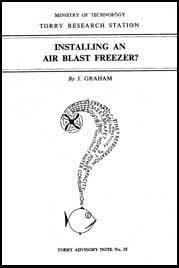Contents Index

Accompanying Notes
Table of Contents
By J. GRAHAM
MINISTRY OF TECHNOLOGY
TORRY RESEARCH STATION
TORRY ADVISORY NOTE No. 35
Crown copyright material is reproduced with the permission of the Controller of Her Majesty's Stationery Office.
This electronic document has been scanned using optical character recognition (OCR) software and careful manual recorrection. Even if the quality of digitalisation is high, the FAO declines all responsibility for any discrepancies that may exist between the present document and its original printed version.
Describes good design and operation of blast freezers, advises on air speed and temperature, freezer capacity, freezing time and correct loading procedures, and considers the effect of product packaging on freezing times. Lists the information a potential buyer needs to provide to specify exactly what is wanted from the equipment, and the information which the potential supplier should provide in order to ensure that the equipment will do the job required. Measurements are given in British units; Note 40 gives conversion factors to SI units.
Following publication of the Note, different designs of continuous air blast freezer were developed. The conveyor can be in the form of a rising spiral to minimise the floor space required. The conveyor belts can be link or mesh types, which are difficult to keep clean with some products, or can be a continuous, stainless steel, flat belt. The 'Torry' freezer is of the last type and enables a wide range of products to be frozen directly on the conveyor without damaging the product when it is released from the belt after freezing, and it is easy to clean. Another design develops a strong air blast from below the conveyor to fluidise the product, as used for freezing peas. A variant, the semi-fluidised freezer, relies on sufficient air blown up through the first section of the conveyor to agitate portion products enough to keep them apart until the surfaces are just frozen hard so that the products remain separate.
(FAO in partnership with Support unit for International Fisheries and Aquatic Research, SIFAR, 2001).
Introduction
Why choose an air blast freezer?
Types of air blast freezer
Air circulation
Air temperature
Freezing time
Freezer capacity
What
happens when the freezer is incorrectly loaded?
Design and spacing of
freezer trays
The effect of wrapping
the product
Defrosting blast freezers
Choice of condenser
Buyer’s specification
Contractor’s specification
Contents Index